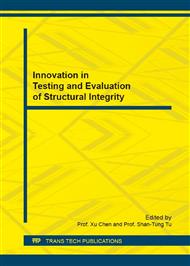[1]
Liu H.W. Shear fatigue crack growth: a literature survey. Fatigue & Fracture of Engineering Materials & Structures. 8(1985)295-313.
DOI: 10.1111/j.1460-2695.1985.tb00429.x
Google Scholar
[2]
Hammouda M.M.I., El-Sehily B.M. A two-dimensional elastic–plastic finite element analysis of friction effects on sliding crack surfaces in full or partial contact. Fatigue & Fracture of Engineering Materials & Structures. 22(1999)101-110.
DOI: 10.1046/j.1460-2695.1999.00143.x
Google Scholar
[3]
Tanaka K. Fatigue crack propagation from a crack inclined to the cyclic tensile axis. Engineering Fracture Mechanics. 6(1974)493-507.
DOI: 10.1016/0013-7944(74)90007-1
Google Scholar
[4]
Otsuka A., Mori K., Ohshima T., Tsuyama S. Mode II fatigue crack growth in aluminium alloys and mild steel. In ICF5, Cannes (France) (1981).
Google Scholar
[5]
Roberts R., Kibler J.J. Mode II fatigue crack propagation. Journal of Fluids Engineering. 93(1971)671-680.
DOI: 10.1115/1.3425325
Google Scholar
[6]
Miller E.E., Sutton M.A., Deng X., et al. Experimental and Predicted Crack Paths for Al-2024-T351 Under Mixed-Mode I/II Fatigue. Fracture, Fatigue, Failure, and Damage Evolution, 5(2015)11-20.
DOI: 10.1007/978-3-319-06977-7_2
Google Scholar
[7]
Matsunaga H., Makizaki M., Socie D.F., Yanase K., Endo M. Mode I Fatigue Crack Growth with Occasional Mode II Loading in 7075 Aluminum Alloy. ICMFF10, (2015).
DOI: 10.1016/j.engfracmech.2014.04.015
Google Scholar
[8]
Fatemi A., Gates N., Socie D.F., Phan N. Fatigue crack growth behaviour of tubular aluminium specimens with a circular hole under axial and torsion loadings. Engineering Fracture Mechanics. 123(2014)137-147.
DOI: 10.1016/j.engfracmech.2014.04.010
Google Scholar
[9]
Otsuka A., Sugawara H., Shomura M. A test method for mode II fatigue crack growth relating to a model for rolling contact fatigue. Fatigue & Fracture of Engineering Materials & Structures. 19(1996)1265-1275.
DOI: 10.1111/j.1460-2695.1996.tb00949.x
Google Scholar
[10]
Richard H.A. A new compact shear specimen. International Journal of Fracture. 17(1981)R105-R107.
DOI: 10.1007/bf00033347
Google Scholar
[11]
Buzzard R.J., Gross B., Srawley J.E. Mode II fatigue crack growth specimen development. ASTM STP. 905(1986)329-346.
DOI: 10.1520/stp17405s
Google Scholar
[12]
Matsunaga H., Makizaki M., Socie D.F., Yanase K., Endo M. Acceleration of fatigue crack growth due to occasional mode II loading in 7075 aluminum alloy. Engineering Fracture Mechanics. 123(2014)26-36.
DOI: 10.1016/j.engfracmech.2014.04.015
Google Scholar
[13]
Nayeb-Hashemi H., Taslim M.E. Effects of the transient Mode II on the steady state crack growth in Mode I. Engineering Fracture Mechanics. 26(1987)789-807.
DOI: 10.1016/0013-7944(87)90029-4
Google Scholar
[14]
Murakami Y., Takahashi K. Torsional fatigue of a medium carbon steel containing an initial small surface crack introduced by tension–compression fatigue: crack branching, non-propagation and fatigue limit. Fatigue & Fracture of Engineering Materials & Structures. 21(1998).
DOI: 10.1046/j.1460-2695.1998.00128.x
Google Scholar
[15]
Otsuka A., Tohgo K., Matsuyama H. Fatigue crack initiation and growth under mixed mode loading in aluminum alloys 2017-T3 and 7075-T6. Engineering Fracture Mechanics. 28(1987)721-732.
DOI: 10.1016/0013-7944(87)90065-8
Google Scholar
[16]
Qian J., Fatemi A. Mixed mode fatigue crack growth: A literature survey. Engineering Fracture Mechanics. 55(1996)969-990.
DOI: 10.1016/s0013-7944(96)00071-9
Google Scholar
[17]
Pandey K., Chand S. An energy based fatigue crack growth model. International Journal of Fatigue. 25(2003)771-778.
DOI: 10.1016/s0142-1123(03)00049-5
Google Scholar
[18]
Kujawski D., Ellyin F. A fatigue crack propagation model. Engineering Fracture Mechanics. 20(1984)695-704.
DOI: 10.1016/0013-7944(84)90079-1
Google Scholar
[19]
Ellyin F. Crack growth rate under cyclic loading and effect of different singularity fields. Engineering Fracture Mechanics. 25(1986)463-473.
DOI: 10.1016/0013-7944(86)90260-2
Google Scholar
[20]
Glinka G. A cumulative model of fatigue crack growth. International journal of fatigue. 4(1982)59-67.
DOI: 10.1016/0142-1123(82)90061-5
Google Scholar
[21]
Shi K.K., Cai L.X., Chen L., Wu S.C., Bao C. Prediction of fatigue crack growth based on low cycle fatigue properties. International Journal of Fatigue. 61(2014)220-225.
DOI: 10.1016/j.ijfatigue.2013.11.007
Google Scholar
[22]
Kujawski D., Ellyin F. A fatigue crack growth model with load ratio effects. Engineering Fracture Mechanics. 28(1987)367-378.
DOI: 10.1016/0013-7944(87)90182-2
Google Scholar
[23]
Hutchinson J. Singular behaviour at the end of a tensile crack in a hardening material. Journal of the Mechanics and Physics of Solids. 16(1968)13-31.
DOI: 10.1016/0022-5096(68)90014-8
Google Scholar
[24]
Rice J., Rosengren G. Plane strain deformation near a crack tip in a power-law hardening material. Journal of the Mechanics and Physics of Solids. 16(1968)1-12.
DOI: 10.1016/0022-5096(68)90013-6
Google Scholar
[25]
Symington M., Shih C.F., Ortiz M. Tables of plane strain mixed-mode plastic crack tip fields. Brown University Report, Providence, RI. (1988).
Google Scholar
[26]
Shih C.F. Elastic-plastic analysis of combined mode crack problems: Harvard University; (1973).
Google Scholar
[27]
Ramberg W., Osgood W.R. Description of stress-strain curves by three parameters: National Advisory Committee for Aeronautics; (1943).
Google Scholar
[28]
Shlyannikov V., Tumanov A. Characterization of crack tip stress fields in test specimens using mode mixity parameters. International Journal of Fracture. 185(2014)49-76.
DOI: 10.1007/s10704-013-9898-0
Google Scholar
[29]
Shlyannikov V.N., Tumanov A.V., Zakharov A.P. The mixed mode crack growth rate in cruciform specimens subject to biaxial loading. Theoretical and Applied Fracture Mechanics. 73(2014)68-81.
DOI: 10.1016/j.tafmec.2014.06.016
Google Scholar
[30]
Ricel J. The mechanics of crack tip deformation and extension by fatigue. Fatigue Crack Propagation, ASTM, ASTM STP. 415(1966).
DOI: 10.1520/stp47234s
Google Scholar
[31]
Hua G., Brown M.W., Miller K.J. Mixed-mode fatigue thresholds. Fatigue & Fracture of Engineering Materials & Structures. 5(1982)1-17.
DOI: 10.1111/j.1460-2695.1982.tb01220.x
Google Scholar
[32]
Li J., Zhang Z., Sun Q., Li C.W., Li R.S. A simple relationship between axial and torsional cyclic parameters. Journal of materials engineering and performance. 20( 2011)1289-1293.
DOI: 10.1007/s11665-010-9748-4
Google Scholar
[33]
Shi K.K., Cai L.X., Bao C. Crack Growth Rate Model under Constant Cyclic Loading and Effect of Different Singularity Fields. Procedia Materials Science. 3(2014)1566-1572.
DOI: 10.1016/j.mspro.2014.06.253
Google Scholar
[34]
Shi K.K., Cai L.X., Bao C., Wu S.C., Chen L. Structural fatigue crack growth on a representative volume element under cyclic strain behavior. International Journal of Fatigue. 74(2015)1-6.
DOI: 10.1016/j.ijfatigue.2014.12.009
Google Scholar
[35]
Yu X., Abel A. Crack surface interference under cyclic mode I and steady mode II loading: Part I: Experimental study. Engineering Fracture Mechanics. 66(2000)503-518.
DOI: 10.1016/s0013-7944(00)00038-2
Google Scholar
[36]
Tong J., Yates R., Brown M.W. A model for sliding mode crack closure part I: Theory for pure mode II loading. Engineering Fracture Mechanics. 52(1995)599-611.
DOI: 10.1016/0013-7944(95)00044-v
Google Scholar
[37]
Matsunaga H., Makizaki M., Yanase K. Finite element modeling of plasticity-induced crack closure due to occasional mode II loading on mode I fatigue crack growth. Engineering Fracture Mechanics. 111( 2013)38-49.
DOI: 10.1016/j.engfracmech.2013.09.001
Google Scholar


